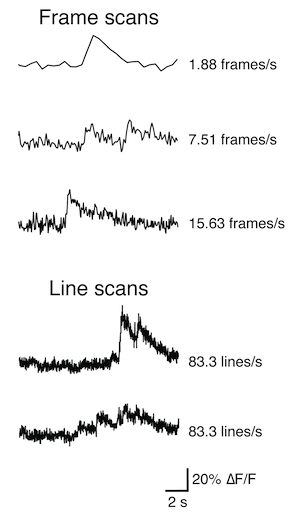Shot noise-limited imaging

What is the advantage of imaging fast in population calcium imaging? Here’s a quick qualitative comparison. The prep was mouse visual cortex, the dye was OGB-1-AM, all traces are unfiltered, and laser power was adjusted to obtain similar photon fluxes per pixel in the different modes. Events are detectable in all cases, but faster is better as long as you’re not cooking the tissue and can keep the noise under control. Also, you’ll want to keep triplet state accumulation from killing your signal.
I saw a nice talk by David DiGregorio at SfN this year. He’s using parked-beam imaging to explore calcium microdomains at the Calyx of Held. Parked-beam imaging is a great way to get ultra high acquisition rates and high signal to noise, but the imaging duration must be very brief. With raster scanning, imaging for hours is perfectly fine, because the duty-cycle for any particular structure is very low. With parked-beam imaging, the usable duration may be well under a second. For many experiments, this isn’t a limitation and his group has obtained beautiful optical recordings of action potentials at high temporal resolution using a DPA+DiO approach. (link)